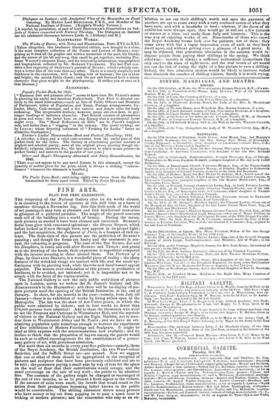FINE ARTS,
PLAN FOR FREE EXHIBITION.
THE reopening of the National Gallery after its six weeks closure, is as cheering to the lovers of pictures at this dull time as a burst of sunshine through a November fog. Into this little nook of the world of art passengers may turn at pleasure and find intellectual recreation in glimpses of a pictorial paradise. The magic of the pencil converts each cell of the building into a world of beauty. During the recess, such pictures as needed it have been cleaned and varnished. RunEws's florid hues glow with renovated splendour: the Brazen Serpent, which before looked as if seen through horn, now appears in its proper light ; and the last acquisition, the Judgment of Paris, is a bouquet of rich co- lours. The flesh-tints of this picture are the perfection of RUMENS'S painting ; and though the forms are heavy and the sentiment is sen- sual, the colouring is gorgeous. The tone of the fine Grano, Lot and his Daughters, is crude and cold after RUMENS and TITIAN; and grand as is the drawing of the heads, their expression is superficial compared with the intense meaning in those around them. The Portrait of a Doge, by GIOVANNI BELLINI, is a wonderful piece of reality : the sharp features of the wrinkled visage are instinct with life, and the small eye fascinates with its piercing look, while the robe and ducal bonnet appear palpable. The minute over-elaboration of this picture is productive of hardness, to be avoided, not imitated; yet it is impossible not to be struck with the force of the representation.
The National Gallery is now the only public exhibition of pictures open in London, unless we reckon the St. James's Gallery and Mr. ATHERSTONE'S in the Haymarket; and there will be no display of mo- dern pictures until the opening of the British Institution at the end of January. In short, for six months in the year—namely, from July till January—there 'is no exhibition of works by living artists open in the Metropolis. The last was the show of Art-Union prizes, to which the public were admitted by tickets ; and in four weeks no fewer than 270,000 persons were admitted! Add to these the thousands who went to see the Frescoes and Cartoons in Westminster Hall, and the myriads of visiters to the National Gallery and the Elgin Marbles, not to men- tion those to Westminster Abbey and St. Paul's ; and we have an art- admiring population quite numerous enough to warrant the experiment of free exhibitions of Modern Paintings and Sculpture. It might be tried at little expense with the accommodations now available ; and we incline to think that the proportion of buyers among the gazers would be such as to afford encouragement for the establishment of a perma- nent gallery of art, with gratuitous admission. For more than six months in every year five galleries—namely, those of the Royal Academy, the British Institution, the two Water-colour Societies, and the Suffolk Street set—are unused. Now we suggest that one or other of them should be appropriated to the reception of pictures and sculpture that have been previously exhibited and are to be sold ; the possessors paying a small sum by way of rent for the space on the wall or floor that their contributions would occupy, and the usual percentage on the sale of any work ; the public to be admitted free. The contents of the gallery might be changed or rearranged at the end of two months, so as to present a fresh aspect to the visiters. If the amount of sales were small, the benefit that would result to the artists from their productions becoming better known to the public would be considerable. The shilling admission deters many persons who have money to lay out from popping in to pass a spare hour in looking at modern pictures; and the economists who stay at an ex- hibition to see out their shilling's worth and save the payment ef another, are apt to come away with a very confused notion of what they have seen, and with a headache to boot ; whereas, if the doors of en exhibition were always open, they would go in and see a few picture!, or statues at a time, and study them fully and leisurely. This is the true way of enjoying works of art. Nine-tenths of those who crowd the Royal Academy rooms look over the pictures, not at them : they come away with but a vague impression even of such as they have dwelt upon, and without getting even a glimpse of a great many. It may be objected, that gratuitous admission in the autumn would in- dispose people from paying their shillings in the spring. We think otherwise : novelty is always a sufficient inducement (sometimes the only one) to the mass of sight-seers, and the real lovers of art would not run the risk of losing the sight of a fine picture to save a shilling. Indeed, the free admission system would be likely to increase rather than diminish the number of shilling visiters. Surely it is worth trying.


























 Previous page
Previous page